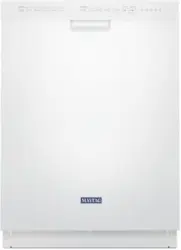Documents: Go to download!
User Manual
- User Manual - (English, French)
- Installation Intructions - (English)
- Dimension Guide - (English)
- Specification Sheet - (English)
- KEY USAGE TIPS
- OPERATING YOUR DISHWASHER
- CYCLE GUIDE
- CYCLE OPTIONS
- DISHWASHER CARE
- TROUBLESHOOTING
Table of contents
User manual Dishwasher
KEY USAGE TIPS
Filtration system
Your dishwasher has the latest technology in dishwasher filtration. The Clean Water Wash system continuously removes food particles from the wash water for excellent performance. Plus, there is no need to ever remove and clean the filter.
Drying - Rinse aid is essential
You must use a drying agent such as a rinse aid for good drying performance. Rinse aid along with the Heated Dry option will provide improved drying and avoid excessive moisture in dishwasher interior.
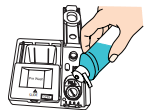
Energy efficiency
The Auto cycle senses load size, soil amount, and toughness of soil. This cycle is optimized to achieve the best cleaning with using minimal water and energy consumption. Efficient dishwashers run longer to save water and energy, just as driving a car slower saves on gas. Your first cycle will run longer to calibrate the optical sensor. When you need fast results, Quick Wash will clean your dishes but use slightly more water and energy

Press START every time you add a dish
IMPORTANT: If anyone opens the door (such as to add a dish, even during a Delay) the START button must be pressed. Firmly push the door closed and press START.

OPERATING YOUR DISHWASHER
1. Prepare and load dishwasher
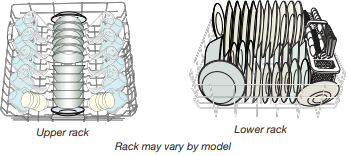
IMPORTANT: Remove leftover food, bones, toothpicks and other hard items from dishes. Remove labels from containers before washing.
- Make sure when dishwasher door is closed, no items are blocking detergent dispenser.
- Items should be loaded with soiled surfaces facing down and inward to the spray as shown in the graphics above. This will improve cleaning and drying results. Angle dirtiest dish surface downward, allowing space for water to flow up through rack and between dishes.
- Avoid overlapping items, like bowls or plates, that may trap food.
- Place plastics, small plates, and glasses in upper rack.
- Wash only items marked “dishwasher safe.”
- To avoid thumping/clattering noises during operation, load dishes so they do not touch one another. Make sure lightweight load items are secured in racks.
- Use slots in the covers and suggested loading patterns to keep your silverware separated for optimum wash.
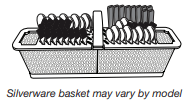
- If your silverware does not fit into the designated slots, lift and slide covers off to remove them and mix silverware types to keep them separated.
- When loading silverware,always place sharp items pointing down and avoid “nesting” as shown.

2. Check that all arms spin freely
Items in the rack can block the spray arms.
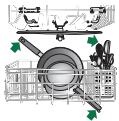
3. Add detergent
Premeasured Detergents
High-quality premeasured tablets and packs are recommended for improved performance.
Quality tablets and packs have been proven better than powder, liquid, or gel detergents at reducing filming on dishes. Using tablets and packs over time will start to reduce or eliminate white film. They are suitable for all water hardness and soil levels. Also, by using a rinse aid, you can minimize repeat buildup of white film (not all packs and tablets contain rinse aid). Always place premeasured detergents in main compartment and close lid.
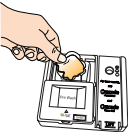
NOTE: Follow instructions on the package when using other dishwasher detergent types. See the complete User Instructions for more details about powders, liquids, and gels.
- Use automatic dishwasher detergent only. Add detergent just before starting a cycle.
- Fresh automatic dishwasher detergent results in better cleaning. Store tightly closed detergent container in a cool,dry place.
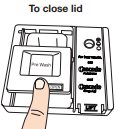 |
 |
|
| Place selected detergent in the dispenser. Place finger, as shown, and slide lid closed. Press firmly until it clicks. | Push OPEN, as shown, and the lid will slide open. |
4. Add rinse aid
- Your dishwasher is designed to use rinse aid for good drying performance. Without rinse aid, your dishes and dishwasher interior will have excessive moisture. The heating and drying options will not perform as well without rinse aid.
- Rinse aid keeps water from forming droplets that can dry as spots or streaks. It also improves drying by allowing water to drain off of dishes after final rinse. Rinse aid does not adhere to dishware, and when used, it is dispensed during each cycle.
- To add rinse aid, open the dispenser lid by gently pushing in the center of the lid with your thumb while lifting up on the edge.
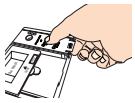
- Pour rinse aid into the opening until the indicator level shows that it is full.

- Rinse aid is dispensed automatically. Be sure to check level and refill as needed.
- Close dispenser by pushing down gently on the lid.
NOTE: For most water conditions, the factory setting will give good results.
If you are experiencing poor drying performance, you may want to try a higher setting. Turn the arrow adjuster to a higher setting to increase the amount of rinse aid dispensed.

5. Select a cycle
Efficient dishwashers run longer to save water and energy, just as driving a car slower saves on gas. Typical cycle time is approximately 21/2 hours but can take less or more time to complete depending on selections. Push door firmly closed and select the cycle appropriate for your load (see Cycle Guide).
6. Select options
You can customize your cycles by pressing the options desired. If you change your mind, press the option again to turn off the option. Not all options are available for every cycle. If an invalid option is selected for a given cycle, lights will flash.
7. START or resume a cycle
NOTE: If needed, run hot water at the sink nearest your dishwasher until the water is hot. Turn off water.
With door firmly closed press START.
IMPORTANT: If the door is opened for more than a few seconds after the cycle is started (even during the Delay time), the START button must be pressed again after the door is closed. If START button is not pressed the START button LED will flash, an audible tone will be heard, and the cycle will not resume.
8. Follow the progress of your dishwasher
The indicator light will indicate the cycle progress such as Add Dish, Washing, Drying, Clean, and Sanitized. The cycle has completed when the Clean light is lit. Refer to the Controls and Cycle Status section for operation of the Sanitized indicator.

CYCLE GUIDE
This information covers several different models. Your dishwasher may not have all cycles and options described.
IMPORTANT: The sensor in your dishwasher monitors the soil level. Cycle time and/or water usage can vary as the sensor adjusts the cycle for the best wash performance. If the incoming water is less than the recommended temperature or food soils are heavy, the cycle will automatically compensate by adding time, heat, and water as needed.
| CYCLES | ESTIMATED WASH TIME* W/O OPTIONS (HH:MM) | WATER USAGE GALLONS (LITERS) | |
| PowerBlast® | Targets toughest food soils. Use for hard-to-clean heavily soiled pots, pans, casseroles, and tableware. | 3:30 to 3:45 | 9.0 (34.2) |
| Auto | Load and soil sensing cycle. This cycle is optimized to achieve best cleaning with minimal water and energy for all soil levels.* | 2:45 to 3:15 | 4.5 to 6.9 (17.0 to 26.0) |
| Normal | This cycle is recommended for daily, regular or typical use to completely wash and dry a full load of normally soiled dishes. This dishwasher’s government energy certifications were based on the Normal cycle with only the Heated Dry option selected.** | 2:30 to 3:30 | 3.0 to 7.4 (11:2 to 27.9) |
| Light | Use for lightly soiled items. It saves energy. | 2:15 to 3:15 | 3.0 to 7.4 (11:2 to 27.9) |
| Quick | For fast results, this cycle will clean your light to medium soiled dishes, but uses slightly more water and energy. For improved drying, select a Heated Dry option. | 1:00 | 5.5 (21.0) |
| Rinse | Use for rinsing dishes, glasses, and silverware that will not be washed right away. Do not use detergent. During cycle, the rinse action will repeatedly pause for several seconds. | 0:07 | 1.3 (5.0) |
*The government energy certifications are not based on this cycle. See the Normal cycle description for the government energy certification cycle. Using the Auto cycle may increase your energy usage.
**No other washing and drying temperature options were selected, and the dishwasher was not subjected to truncated testing. Rinse aid was not used, and there was no detergent used in the prewash.
CYCLE OPTIONS
| OPTIONS | CAN BE SELECTED WITH | WHAT IT DOES | ADDED TIME TO CYCLE | ADDED WATER GALLONS (LITERS) | |
| High Temp | Raises main wash temperature to improve cleaning for loads containing tough, baked-on food. | Auto PowerBlast™ Normal | Raises main wash temperature to a minimum of 129F (53.9 C). Press and hold the button for 3 seconds to turn on/off sound. | 0:00 to 1:00 | 0 – 3.3 (0 – 12.5) |
| Sanitize | Sanitizes dishes and glassware in accordance with NSF International NSF/ANSI Standard 184 for Residential Dishwashers. Certified residential dishwashers are not intended for licensed food establishments. Only sanitizing cycles have been designed to meet the requirements of the NSF/ANSI 184 performance standard for soil removal and for sanitization efficacy. There is no intention, either directly or indirectly, that all cycles on a NSF/ANSI 184 certified dishwasher meet the NSF/ANSI 184 performance standard for soil removal and for sanitization efficacy. The Sani Rinse indicator glows at the end of the cycle if the Sani Rinse option was successfully completed. If your load did not properly sanitize, the indicator light will flash at the end of the cycle. This can happen if cycle is interrupted or if the water does not reach the required temperature. The light goes off when you open and close the door or press CANCEL. | Auto PowerBlast™ Normal | Raises the main wash temperate to145°F (62.8°C) and the final rinse temperature to (156°F (69°C). | 0:15 to 1:30 | 0 – 3.7 (0 – 14.0) |
| Heated Dry | Dries dishes with heat. Use option with rinse aid to provide best drying results. Plastic items are less likely to deform when loaded in top rack. Use Heat Dry for optimum drying performance. Turn option off for an air dry. | Auto PowerBlast™ Normal Quick Light | Uses a heating element to speed drying times. Heat Dry option defaults to On when any cycle is selected except for Quick and Rinse. | 0:11 to 0:46 | |
| 4-Hour Delay |
Runs dishwasher at a later time or during off-peak electrical hours. Select a wash cycle and options. Press Delay button to delay the cycle by 4 hours. Close door firmly. Press START. NOTE: Any time the door is opened (such as, to add a dish), the START keypad must be touched again to resume the delay countdown. |
Available with any cycle | Delays start of a cycle by 4 hours. | ||
| Control Lock (Hold 3 Sec) |
Use the Control Lock option to avoid unintended use of dishwasher between cycles and/or during cycles. To turn on Control Lock, press and hold Control Lock for 3 seconds. Control Lock light will stay on for a short time, indicating that it is activated. When the Lock indicator is lit, all buttons are disabled. If you press any button while your dishwasher is locked, the light flashes 3 times. The dishwasher door can still be opened/closed while the controls are locked. To turn off Control Lock, press and hold Control Lock for 3 seconds. Control Lock light turns off. |
||||
| CONTROL | PURPOSE | COMMENTS |
 |
Press to START or resume a wash cycle | If the door is opened during a cycle or the power is interrupted, the START button LED flashes. Cycle will not resume until door is closed and START is pressed. |
 |
Press to CANCEL wash cycle | Close the door firmly. Press and hold CANCEL for 3 seconds. The dishwasher starts a 2-minute drain (if needed). Let dishwasher drain completely. |
DISHWASHER CARE
Cleaning the Exterior
Clean the exterior of the dishwasher with only a soft, damp cloth, and mild detergent. If your dishwasher has a stainless steel exterior, it may have a coating that is resistant to fingerprints. Avoid using abrasive cleaning products on the exterior of the dishwasher.
Cleaning and Maintaining the Interior
Many detergents may leave white spots or a white residue on dishware and on the interior of the dishwasher. Over time this residue can become unsightly and could affect dishwasher performance. Use of a dishwasher cleaning product such as affresh®† Dishwasher Cleaner can help to remove the residue. Monthly use of affresh®† Dishwasher Cleaner is recommended to help maintain the dishwasher. Follow package directions.
NOTE: Maytag recommends the use of high-quality, premeasured detergent tablets or packs and the use of rinse aid for dishwasher cleaning and daily care.
If you have a drain air gap, check and clean it if the dishwasher isn’t draining well.

To Reduce Risk of Property Damage During Vacation or Extended Time Without Use
- When you will not be using the dishwasher during the summer months, turn off the water and power supply to the dishwasher.
- Make sure the water supply lines are protected against freezing conditions. Ice formations in the supply lines can increase water pressure and cause damage to your dishwasher or home. Damage from freezing is not covered by the warranty.
- When storing your dishwasher in the winter, avoid water damage by having your dishwasher winterized by authorized service personnel.
TROUBLESHOOTING
| If you experience | Recommended Solutions |
| Dishwasher does not run or stops during a cycle |
It is normal for certain cycles to repeatedly pause for several seconds during the main wash. Is the door closed tightly and latched? Is the right cycle selected? Is there power to the dishwasher? Has a household fuse blown, or has a circuit breaker tripped? Replace the fuse or reset the circuit breaker. If the problem continues, call an electrician. Has the motor stopped due to an overload? The motor automatically resets itself within a few minutes. If it does not restart, call for service. Is the water shutoff valve (if installed) turned on? |
| The START indicator is flashing | If the Start light is flashing, close the door and press START within 4 seconds. If the Clean light or any other lights are blinking and the dishwasher will not run. |
| Dishes do not dry completely |
NOTE: Plastic and items with nonstick surfaces are difficult to dry because they have a porous surface which tends to collect water droplets. Towel drying may be necessary. Use of rinse aid along with the Heated Dry option is needed for proper drying. Proper loading of items can affect drying. Adjust your rinse aid dispenser to a higher number, allowing a larger amount of rinse aid to dispense. See section on adding rinse aid. Glasses and cups with concave bottoms hold water. This water may spill onto other items when you are unloading the dishwasher.
|
| Noise |
NOTE: Common noises:
|
| Spotting/Filming | Liquid rinse aid is necessary for drying and to reduce spotting. Use the correct amount of detergent. Confirm that the cloudiness is removable by soaking the item in white vinegar for 5 minutes and dry the item. If the cloudiness disappears, it is due to hard water. Adjust the amount of detergent and rinse aid. See the “Dishwasher Care” section. If the cloudiness on glass does not come clear, it is due to etching. Be sure the incoming water temperature is set at 120°F (49°C).Try using the High Temp Wash or Sani Rinse option. |
| Dishwasher does not clean completely |
Be sure the dishwasher is loaded correctly. Improper loading can greatly decrease the washing performance. Check that all spray arms spin freely. Select the proper cycle for the type of soils. The Auto or PowerBlast® cycle can be used for tougher loads. Be sure the incoming water temperature is at least 120°F (49°C). Use the proper amount of fresh detergent. More detergent is needed for heavier soiled loads or hard water conditions. Scrape food from dishes prior to loading (do not prerinse). If foam or suds are detected by the dishwasher sensing system, the dishwasher may not operate properly or may not fill with water. Suds can come from:
|
| Dishwasher does not drain |
Be sure the cycle has been completed (the Clean light is on). If it has not, resume the cycle by closing the door and pressing START. If dishwasher is connected to a food waste disposer, be sure the knockout plug has been removed from the disposer inlet. Check for kinks in the drain hose. Check for food obstructions in the drain or disposer. Check your house fuse or circuit breaker. |
See other models: MDB8959SFZ MDB7959SHZ MMV1174FB MMV5220FZ MMV6190FZ
